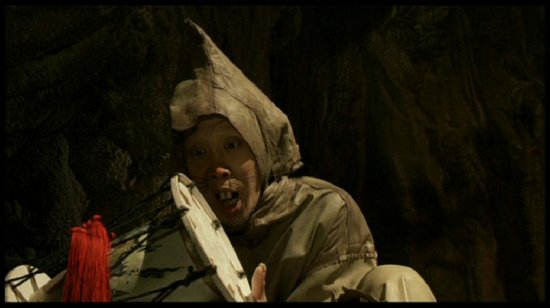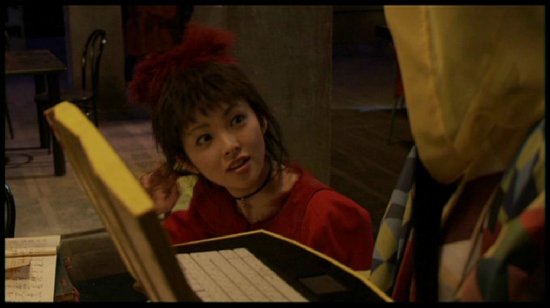Kitaro And The Millennium Curse Full Movie Part 1
Film score - Wikipedia. A film score (also sometimes called background score, background music, film soundtrack, film music, or incidental music) is original music written specifically to accompany a film.
The score forms part of the film's soundtrack, which also usually includes pre- existing music, dialogue and sound effects, and comprises a number of orchestral, instrumental, or choral pieces called cues, which are timed to begin and end at specific points during the film in order to enhance the dramatic narrative and the emotional impact of the scene in question.[1] Scores are written by one or more composers, under the guidance of, or in collaboration with, the film's director or producer and are then usually performed by an ensemble of musicians – most often comprising an orchestra or band, instrumental soloists, and choir or vocalists – and recorded by a sound engineer. Film scores encompass an enormous variety of styles of music, depending on the nature of the films they accompany. The majority of scores are orchestral works rooted in Western classical music, but many scores are also influenced by jazz, rock, pop, blues, new- age and ambient music, and a wide range of ethnic and world music styles.

Forex Margin Call Explained - babypips.com www.babypips.com/./margin-call-exemplified.html Learn what a margin call is in forex trading and watch how quickly you. Issuu is a digital publishing platform that makes it simple to publish magazines, catalogs, newspapers, books, and more online. Easily share your publications and get. Showtime Full Rogues Gallery Online Free.
Since the 1. 95. 0s, a growing number of scores have also included electronic elements as part of the score, and many scores written today feature a hybrid of orchestral and electronic instruments.[2]Since the invention of digital technology and audio sampling, many modern films have been able to rely on digital samples to imitate the sound of live instruments, and many scores are created and performed wholly by the composers themselves, by using sophisticated music composition software. Songs are usually not considered part of the film's score,[citation needed] although songs do also form part of the film's soundtrack.[3] Although some songs, especially in musicals, are based on thematic ideas from the score (or vice versa), scores usually do not have lyrics, except for when sung by choirs or soloists as part of a cue. Similarly, pop songs which are "needle dropped" into a specific scene in film for added emphasis are not considered part of the score, although occasionally the score's composer will write an original pop song based on their themes, such as James Horner's "My Heart Will Go On" from Titanic, written for Celine Dion. Process of creation[edit]Spotting[edit]The composer usually enters the creative process towards the end of filming, at around the same time as the film is being edited, although on some occasions the composer is on hand during the entire film shoot, especially when actors are required to perform with or be aware of original diegetic music. Watch Say Anything... Putlocker here. The composer is shown an unpolished "rough cut" of the film, before the editing is completed, and talks to the director or producer about what sort of music is required for the film in terms of style and tone.
The director and composer will watch the entire film, taking note of which scenes require original music. During this process the composer will take precise timing notes so that he or she knows how long each cue needs to last, where it begins, where it ends, and of particular moments during a scene with which the music may need to coincide in a specific way. This process is known as "spotting".[4]Occasionally, a film maker will actually edit his film to fit the flow of music, rather than have the composer edit his score to the final cut. Director Godfrey Reggio edited his films Koyaanisqatsi and Powaqqatsi based on composer Philip Glass's music.[5] Similarly, the relationship between director Sergio Leone and composer Ennio Morricone was such that the finale of The Good, the Bad and the Ugly and the films Once Upon a Time in the West and Once Upon a Time in America were edited to Morricone's score as the composer had prepared it months before the film's production ended.[6]In another notable example, the finale of Steven Spielberg's E. T. the Extra- Terrestrial was edited to match the music of his long- time collaborator John Williams: as recounted in a companion documentary on the DVD, Spielberg gave Williams complete freedom with the music and asked him to record the cue without picture; Spielberg then re- edited the scene later to match the music.
Essential Practice for Healthcare Assistants, Angela Grainger 9780078764301 0078764300 Glencoe Literature: Reading Wi. Un libro (del latín liber, libri) es una obra impresa, manuscrita o pintada en una serie de hojas de papel, pergamino, vitela u otro material, unidas por un lado (es. Watch They Streaming more. Paulo 49074 São 46318 do 40723 Brasil 38043 da 37922 Da 35214 US$ 33367 Folha 2900 Local 19724 Reportagem 1790 José 15364. English Anime Movies Online from AnimePlus.tv. California Crisis: Gun Salvo: Code Geass: Boukoku no Akito 2 Movie: Call Me Tonight. Big Bang Theory Säsong 1-8! DVD. 699 kr Big bang theory säsong 1-8 Världens snillen, förenen eder! Kasta dig in i kvantfysisk komedi med de otroligt roliga och.
In some circumstances, a composer will be asked to write music based on his or her impressions of the script or storyboards, without seeing the film itself, and is given more freedom to create music without the need to adhere to specific cue lengths or mirror the emotional arc of a particular scene. This approach is usually taken by a director who does not wish to have the music comment specifically on a particular scene or nuance of a film, and which can instead be inserted into the film at any point the director wishes during the post- production process. Composer Hans Zimmer was asked to write music in this way in 2. Christopher Nolan's film Inception; [7] composer Gustavo Santaolalla did the same thing when he wrote his Oscar- winning score for Brokeback Mountain.[8]Syncing[edit]When writing music for film, one goal is to sync dramatic events happening on screen with musical events in the score. There are many different methods for syncing music to picture.
These include using sequencing software to calculate timings, using mathematic formulas and free timing with reference timings. Composers work using SMPTE timecode for syncing purposes.[9]When syncing music to picture, generally a leeway of 3- 4 frames late or early allows the composer to be extremely accurate. Using a technique called Free Timing, a conductor will use either (a) a stop watch or studio size stopclock, or (b) watch the film on a screen or video monitor while conducting the musicians to predetermined timings.
These are represented visually by vertical lines (streamers) and bursts of light called punches. These are put on the film by the Music Editor at points specified by the composer. In both instances the timings on the clock or lines scribed on the film have corresponding timings which are also at specific points (beats) in the composer/conductor score. Written click track[edit]A written click track is a method of writing bars of music in consistent time values (i. Bpm). A composer would use a written click if they planned to conduct live performers.
When using other methods such as a metronome, the conductor has a perfectly spaced click playing in his ear which he conducts to. This can yield stiff and lifeless performances in slower more expressive cues. One can convert a standard BPM value to a written click where X represents the number of beats per bar, and W represents time in seconds, by using the following equation: 6.
W{\displaystyle {\frac {6. W}Written clicks are expressed using 1/3 second increments, so the next step is to round the decimal to either 0, 1/3, or 2/3 of a second.
The following is an example for 8. BPM: 6. 08. 8(4)=2. Once the composer has identified the location in the film they wish to sync with musically, they must determine the musical beat this event occurs on. To find this, they use the following equation, where bpm is beats per minute, sp is the sync point in real- time (i. B is the beat number in 1/3 increments (i. B{\displaystyle {\frac {bpm(sp)}{6.
B}Writing[edit]Once the spotting session has been completed and the precise timings of each cue determined, the composer will then work on writing the score. The methods of writing the score vary from composer to composer; some composers prefer to work with a traditional pencil and paper, writing notes by hand on a staff and performing works- in- progress for the director on a piano, while other composers write on computers using sophisticated music composition software such as Digital Performer, Logic Pro, Finale, Cubase, or Protools.[1. Working with software allows composers to create MIDI- based demos of cues, called MIDI mockups, for review by the filmmaker prior to the final orchestral recording.
